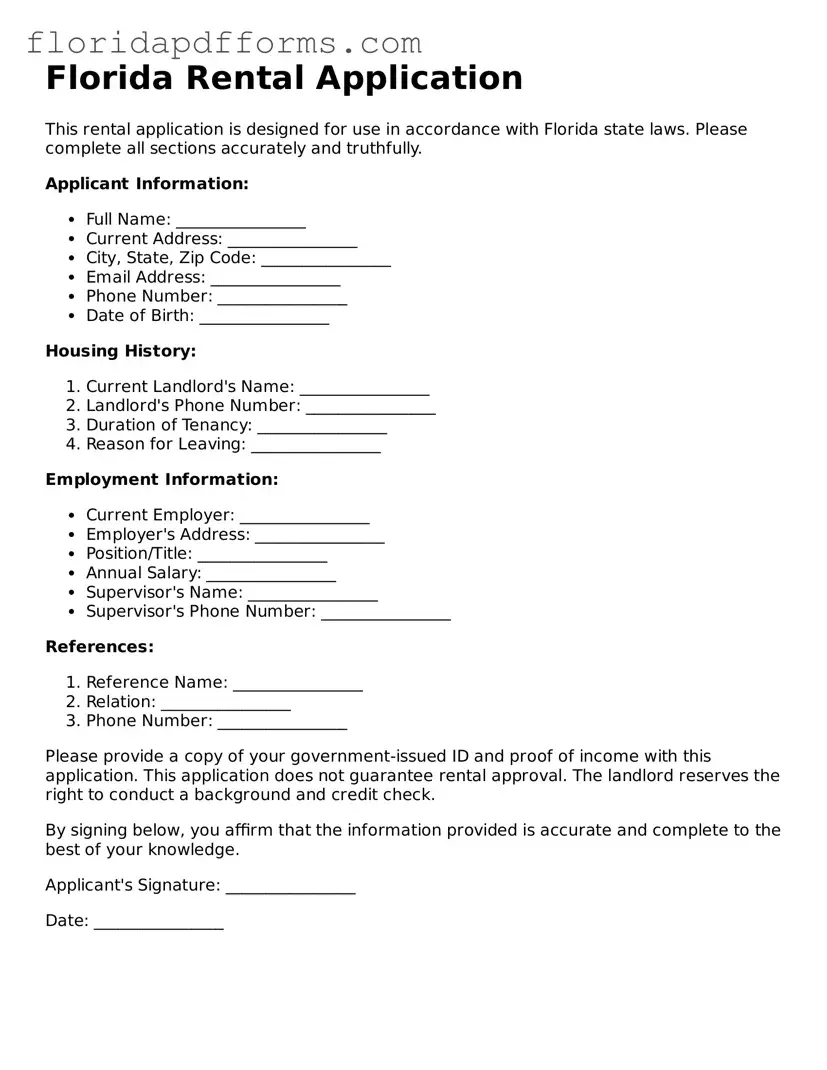The Florida Rental Application form shares similarities with the standard Lease Agreement. Both documents are essential in the rental process, ensuring that the rights and responsibilities of both landlords and tenants are clearly defined. While the Rental Application collects personal information and rental history from potential tenants, the Lease Agreement formalizes the terms of occupancy, including rent amount, duration, and rules governing the property. Together, they establish a comprehensive understanding of the rental relationship.
Another document that resembles the Florida Rental Application is the Tenant Screening Report. This report provides an in-depth look into a prospective tenant's background, including credit history, criminal records, and rental history. While the Rental Application gathers initial information, the Tenant Screening Report offers a more detailed analysis, helping landlords make informed decisions about who to rent to. Both documents aim to protect the interests of landlords while ensuring tenants are qualified for the rental property.
The Rental Reference Form is also similar to the Florida Rental Application. This document is often requested by landlords to verify a potential tenant's rental history and conduct. It typically includes contact information for previous landlords, who can provide insights into the tenant's behavior and reliability. While the Rental Application collects this information directly from the tenant, the Rental Reference Form allows landlords to obtain third-party verification, adding another layer of assurance in the tenant selection process.
A Credit Application is another document that aligns closely with the Florida Rental Application. This form specifically focuses on a tenant's creditworthiness, asking for details about income, debts, and financial history. While the Rental Application may touch on financial aspects, the Credit Application delves deeper into the tenant’s ability to meet financial obligations. Both documents serve to evaluate the tenant’s suitability, but the Credit Application provides a focused view of their financial health.
The Employment Verification Form bears similarities to the Florida Rental Application as well. This document is used to confirm a tenant’s employment status and income level. Landlords often require this information to ensure that tenants can afford the rent. While the Rental Application may ask for employment details, the Employment Verification Form requires direct confirmation from the employer, adding credibility to the tenant's claims about their income.
The Guarantor Application is another document that parallels the Florida Rental Application. This form is used when a tenant requires a guarantor—someone who agrees to take responsibility for the lease if the tenant fails to meet their obligations. Similar to the Rental Application, the Guarantor Application collects personal and financial information to assess the guarantor's ability to support the tenant. Both documents play a crucial role in the rental process, especially for tenants who may not have a strong financial background.
The Move-In Checklist is also related to the Florida Rental Application. While the Rental Application focuses on tenant qualifications, the Move-In Checklist documents the condition of the rental property before the tenant takes possession. This checklist helps protect both parties by providing a record of any existing damages or issues. It ensures that tenants are not held responsible for pre-existing conditions, and it aligns with the information collected in the Rental Application regarding the tenant's understanding of property care.
Finally, the Pet Application is similar to the Florida Rental Application, especially for tenants with pets. This document gathers information about the pet, including breed, size, and vaccination records. Many landlords require a separate Pet Application to assess any potential risks or liabilities associated with having pets on the property. Both applications work together to ensure that all aspects of a tenant's lifestyle are considered in the rental process, providing a complete picture of the tenant's suitability.
